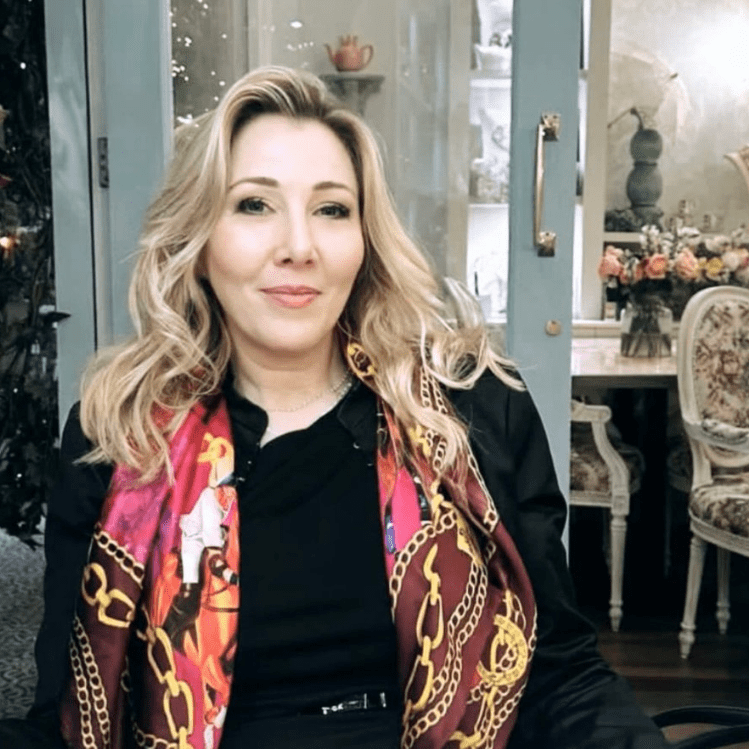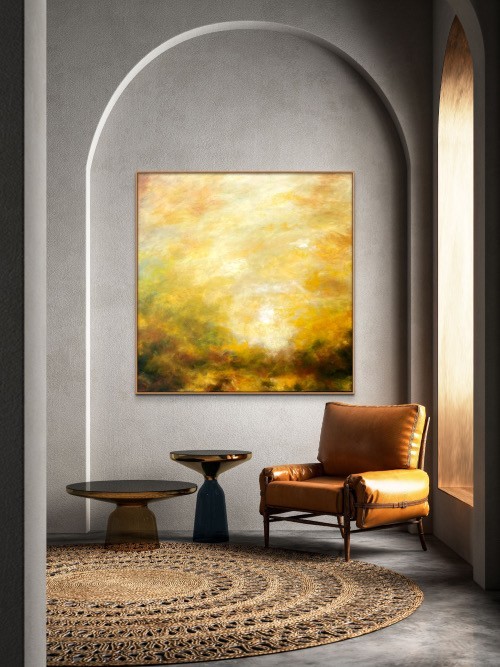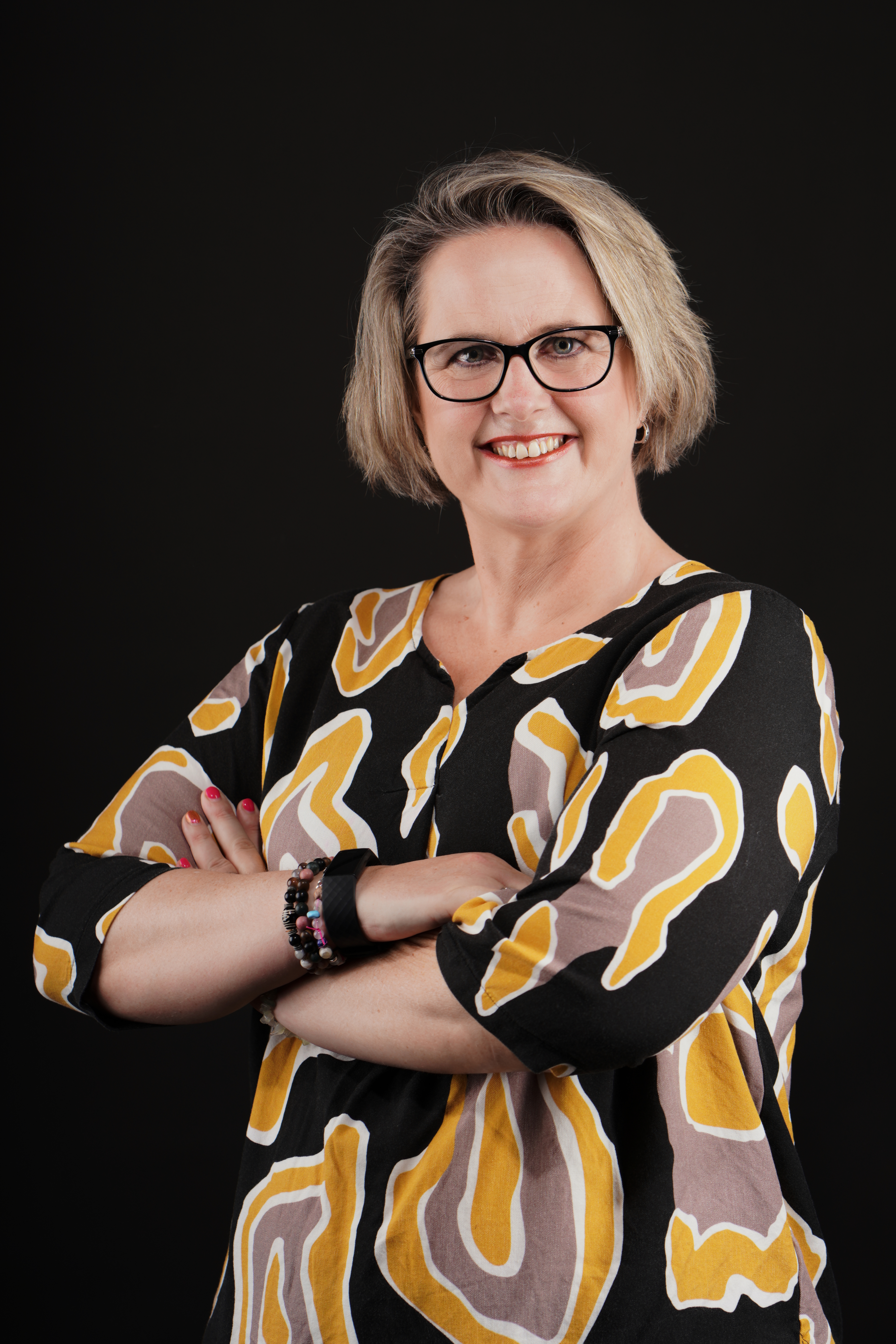
Brushstrokes of Elegance: The Artistic Odyssey
Step into the vibrant world of Cerise Washington, where each brushstroke tells a story of passion, inspiration, and creative evolution. Cerise Washington, the founder of Washington Fine Art, has dedicated her distinguished career to the mesmerising realms of abstract and impressionist paintings in oil and acrylic. But her journey from the corridors of advertising to the canvas of fine art is as captivating as her artwork itself. Influenced by the luminous palette of British master JMW Turner and fueled by two decades of cultural immersion across multiple countries, Cerise’s art is a fusion of global experiences and artistic expression. Now, as she ventures into the realm of silk scarves, each piece intricately crafted from her original paintings, Cerise invites you to embark on a journey where artistry meets elegance, style, and high fashion. Join her as she expands her artistic horizons, weaving her creations into the fabric of luxury and sophistication.
What inspired your transition from a career in advertising to fine art?
At the age of 13, it became evident to both my parents and teachers that I possessed a natural talent for art. To nurture this gift, my parents enrolled me in an adult art evening class, where the course tutor graciously made an exception for my age. Over the years, she provided unwavering support, guiding and challenging me to paint. I became deeply convinced that becoming a renowned painter was my destiny.
My career advisor and parents guided me away from the uncertain path of fine art and toward the emerging field of graphic design upon leaving school. They believed this would provide a more stable and commercially viable outlet for my artistic abilities, while still allowing me to pursue fine art as a hobby. Embracing this advice, I excelled as a graphic designer and art director, which led me to wonderful positions in Dubai, including roles at Ogilvy & Mather and Orbit Showtime Network Dubai.
During my tenure in Dubai, I married my long-time Lebanese boyfriend and soon embraced motherhood, redirecting my focus from advertising to nurturing my two daughters. Amidst this transformative period, I returned to my passion for painting, drawing inspiration from the vibrant hues and rich artistic traditions of both the UAE and Lebanon, where I had immersed myself for many years.
Regrettably, I endured very personal trials during my time in Dubai. Along with the sudden loss of my dear father to cancer, my husband and I separated, and we relocated to Beirut (Lebanon) from Dubai to live in separate homes, all of this within six months. This was a very dark and difficult period for me.
Initially, I didn’t know that many people in Lebanon except for my husband, my daughters, and a few expat friends from the American school. Many of my friends were in Dubai, but it was a mutual agreement between my husband and I that we would try living in Lebanon, and before we separated, I was very keen to live there as a family. However, as we separated, my husband was afraid of me returning to the UK with my girls and not returning to live in Lebanon, so for 5 years I was only able to leave the country and return to see my family without my children. I understood his fears, but living in Lebanon with my daughters and grieving was very hard for me. But again, my art provided me with moments of solace and a connection to my father, who had always been my rock.
I embarked on a journey of self-reinvention, writing a book, and embracing solitude as an opportunity for introspection. It was during these solitary moments in England and Lebanon that my artistic endeavours flourished. The act of painting became a cathartic outlet, allowing me to channel my emotions and transform adversity into creative expression. I find it remarkable how adversity can serve as a catalyst for positive change, reshaping one’s perspective and fostering personal growth.
In 2016, upon my divorce, the girls and I came to live in Wimbledon, London. I realized that the time had come to pursue my lifelong dream of making painting my full-time profession. It was clear that I had come full circle, back to where I started before leaving school, but now with a mature artistic style and the determination to succeed. This return to my roots has given me confidence in my creativity and self-expression, providing me with the freedom and satisfaction that I had longed for. Working with oils and acrylics on canvas to create and sell art that can enrich someone’s home or office has brought me immense joy and fulfilment.
Which British master influenced your artistic style?
For years, I unofficially studied art from various periods and experimented with my learning, experiencing both success and disappointment in equal measure. Upon my return to London, I enrolled in a Christie’s Education course, pursuing a diploma in the Fundamentals of Western Art. This course delved not only into the history of Western European art from the Renaissance to the present, but also into the evolution of the art market and the history of collecting.
I had always admired the likes of J.M.W. Turner and his use of light both on land and over water, and I gravitated towards his works on any occasion. During my time at Christie’s, I was able to study him more formally, and as a result, my understanding of his work deepened enormously. It was about this time that I had started to experiment with abstract art, and I found that his style, his use of vibrant colours, and his expressive brushwork translated easily for me into abstract and profoundly shaped my own artistic expression.

How did living in Beirut, Lebanon, and experiencing its surroundings influence your art?
Living in countries across the Middle East for two decades (sixteen years in Dubai, a year in Kuwait, and three years in Beirut) and extensively travelling within these regions to immerse myself in their cultures and traditions has exposed me to an array of lights, shades, landscapes, and colour palettes that have profoundly influenced my artistic journey. Thanks to the availability of materials, I can typically replicate the colors I’ve encountered anywhere in the world. However, what really fascinates and challenges me is capturing these colors in the man-made shapes and designs inherent to each culture. The architectural marvels, intricate furniture, and ornate decorations found in these regions reflect not only creativity but also intellect and ingenuity. While nature offers an endless array of inspiration for artists, I find equal fascination in the colours used in man-made objects and structures that populate our surroundings. My experiences in the Middle East shape my unique perspective, which I incorporate into my work to add depth and richness.
Lebanon, with its rich, opulent history and French influence, holds an extremely special place in my heart. Often, I draw inspiration from the past, incorporating abstract interpretations of historical elements into my artwork. These glimpses of Lebanon’s heritage breathe life into my pieces in ways that simply wouldn’t be possible without my deep connection to the region.
What are some characteristics of your abstract and impressionist paintings?
In the early stages of my repertoire, I painted figures and portraits in intricate detail, capturing the essence and intricacies of each subject with precision and finesse. In a sense, the transition to abstract and impressionist work freed me from this level of detail, but I have found that the use of colour and shade are all the more important when one does not have an exact subject to work from and recreate.
My abstract and impressionist paintings, influenced by J.M.W. Turner, include vibrant colours and painterly brush strokes, as well as an emphasis on capturing the fleeting effects of light and atmosphere. I find these styles to have, in some respects, more life to them than portraiture, as impressionist works can convey the feel of movement and variety of change more clearly and allow the viewer of my art to feel the emotion and transitions in my paintings intuitively.

Apart from private homes, where have you shown your paintings?
Private commissions have consumed my work for some years, so regular exhibitions have become a challenge and something I need to focus on more in the future.
I had the privilege of exhibiting my equestrian paintings at the World Trade Centre in Dubai, an event primarily for the Middle East’s equestrian industry. His Highness Sheikh Mohammed bin Rashid Al Maktoum opened this event and graciously observed my work with his entourage. This was an unbelievable privilege and something I will never forget.
The Oxford International Art Fair and other locations around London, such as Acton, Covent Garden, and Wimbledon (where I had my studio for several years), have featured my works.
Elle Decor Middle East, House and Garden UK, and London Life magazines have showcased my paintings outside of formal exhibitions. I am fortunate to have received private commissions from celebrities and prominent interior design projects. CEOs of blue-chip companies in America and London have extended these commissions, displaying my paintings in their offices and private homes in Dubai, Paris, and London.
How do you collaborate with interior designers in your artistic endeavours?
Engaging in collaborative efforts with interior designers as an artist presents a mutually enriching partnership, benefiting both the visual allure and practical functionality of a space. By consistently networking in the London art community, my agent, Pandora Mather-Lees, has often facilitated remarkable opportunities for me. By promoting my work to interior designers and carefully ensuring that our styles and requirements align, I can meet the needs and aspirations of the design and help to provide a seamless integration of my artwork into a diversity of environments.
As I live in London, where the art scene is truly vibrant, networking plays a pivotal role for artists. Attending events in central London provides invaluable opportunities to engage with a large array of professionals, including designers, architects, and individuals from various backgrounds. I cannot emphasise enough the significance of networking for artists, as it serves as a conduit for forging meaningful connections, exploring collaborative ventures, and ultimately expanding one’s artistic horizons and opportunities. Artists working with interior designers also need to realise that it is not unusual to work within the confines of a non-disclosure agreement, which makes advertising your accomplishments somewhat difficult!
I recently collaborated with an interior designer on a commission to produce three artworks for a VIP American client who owned a penthouse suite in Covent Garden, London, and a residence in the States. One of the artworks was a recreation of a painting I had previously painted but scaled up to 2 metres by 2 metres for his living room. This was a really exciting project, as I had the canvas specially made and delivered to my studio, and the logistics of delivering such large artwork required meticulous planning. To ensure a smooth delivery for the designer, I acquired the necessary permits and carefully considered logistics such as navigating stairs and fitting the piece into the lift. Understanding the stress the interior designer may be under during installation, I made sure all arrangements were in place beforehand to ease the process. Having had the opportunity to view the penthouse suite during its design stages allowed me to envision how my artwork would fit within the overall aesthetic. Observing design elements such as sofa colours, cushion patterns, curtain hues, and the overall colour scheme provided insight into the client’s vision and allowed me to tailor my artwork accordingly.

What prompted you to venture into creating silk scarves?
The potential avenues for my fine art silk scarves are boundless, and the idea of transferring my art to scarves and other accessories came to me when I was shopping for a gift for a friend and realised how beautifully fine art can be represented on the medium of silk and that I could do this for myself with my art. I was aware that I already had a diverse portfolio of oil paintings that I could incorporate into my silk creations. Presently, I’m refining my collection of polo silk scarves, with aspirations to exhibit them at venues like Cheltenham Racecourse and potentially introduce them to prominent retail outlets both here in the UK and Dubai. Furthermore, my affinity for sailing has opened up a new realm of inspiration. Through my experiences at venues like the Royal Thames Yacht Club in Knightsbridge, I’ve recognised the opportunity to provide the sailing fraternity and those that, like me, love the sea with themed scarves and accessories. By crafting scarves and pocket chiefs adorned with paintings of sail yachts and maritime motifs, I aim to capture the essence of nautical elegance and appeal to enthusiasts of maritime style and culture.
How do you translate your original paintings onto silk scarves?
I am collaborating with a print production house to fine-tune the designs, as it takes a lot of trial and error to enable the transition from painting to digital to silk. Translating designs from original paintings onto silk scarves involves several steps. First, we carefully digitise the artwork to ensure the highest quality reproduction. Next, we adjust and scale the design to suit the scarf’s dimensions. Next, a specialised printing facility receives the digital file and uses advanced printing techniques to transfer it onto the silk fabric. To create the final scarf product, the printed fabric is finished with hand-rolled edging and other details. Maintaining the integrity of the original artwork throughout this process requires meticulous attention to detail and quality.

Which industries are you currently targeting to sell your silk scarves to?
As I mentioned above, I am bringing my silk accessories to the maritime industry, and I’m thrilled to announce that, through representation by ArtonSuperyachts, I’ve secured my first order from a superyacht charter group to provide my silk scarves for their clients’ guests onboard. This success fuels my desire to further target this industry, as well as the cruise industry, the Middle East, and the UK, for the sale of my silk scarves, as I recognise these regions’ affinity for luxury and exquisite craftsmanship.

What are your future aspirations for your fine-art silk scarves?
I am excited about the potential avenues for my fine art silk scarves, and, as always, I am considering diversifying into other traditional silk accessories. I am so busy with commissions and paintings that this venture has taken me by storm. I love the idea that through this work, so many more people will be able to own an original piece of my fine art or a piece of abstract or impressionistic work. I understand that owning an original painting is something that comparatively few people can afford, but owning a beautiful silk scarf that can be worn in so many different ways (or even framed and put on a wall) is so much more affordable. It oozes style and sophistication while being practical, making it the ideal gift for so many occasions. It is so exciting to be at the start of another project that feels like it will take me to wonderful places and bring people happiness and a touch of classic luxury and sophistication. There are no bounds to this project, which is so exciting. Watch this space!

APPLY TODAY
100 Top Global Women Entrepreneurs – Global Woman Magazine
Our Journey in 12 Months:
Our Journey in 12 Months – Global Woman Magazine
5 Things That Show Money is Not Evil:
5 Things to Show That Money Is Not Evil – Global Woman Magazine
Global Man Magazine Page:
Global Woman, Global Man: Socials:
Global Woman Magazine (@global_woman.magazine) • Instagram photos and videos



